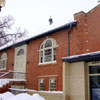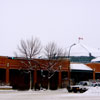Lethbridge - The 1970s Onward

The 1970s ushered in an era of development west of the Oldman River marked most notably by the construction of the University of Lethbridge. The campus, designed by famed architect Arthur Erickson, opened its doors to students in the fall of 1972. Much of campus activity was to be located in a long, inter-connected building with a total length of over 1,000 feet.

Residential development on the west side was ideal for city planners because of the availability of land-west Lethbridge featured a seemingly endless horizon of land with few physical barriers. City officials divided the Westside into three subdivisions: Varsity Village, Indian Battle Heights and Mountain heights. Varsity Village was nearest the University and featured single family dwellings along cul-de-sac roads connecting to main streets. Original plans called for 30,000 residents. Whoop-Up Drive, a major road connecting the downtown with West Lethbridge was opened in 1975. Gradually, commercial services were developed including West Village Mall, a short walk from the University. In 1981, Nicholas Sheran Elementary was the first school built.

Commercial development continued to spring up in all corners of the city. The northside witnessed the construction of two major shopping centres-Centre Village Mall and Park Meadows Mall, built in 1971 and 1979 respectively. However, Lethbridge's central business district remained the busiest locale for commercial activity. The city's only downtown mall, Lethbridge Centre, opened in 1975 and was built by Poole Construction of Calgary. Southland Terrace and Chancery Court, two prominent business blocks, were opened three years later. Meanwhile, the area immediately west of 5th Street South received significant upgrades.

In 1978, the city annexed the community of Hardieville creating a larger northside. In the early 1980s the federal government invested millions into improving the infrastructure of local communities. Known as neighbourhood improvement funds, monies were spent on upgrading infrastructure, building parks, cultural, and leisure facilities. For instance, the Urban Parks Program funded the conversion of the old Galt Hospital into the Galt Museum and Archives in the early 1980s. Reopened in 1984, new gallery space and expanded storage space allowed the museum to develop new programs and temporary exhibits. Individual homeowners could make applications to receive funding specific to home renovations and improvements. Two neighborhoods who received funding were Westminster neighbourhood on the northside and London Road neighborhood immediately south of downtown. By 1983, the federal government had spent more than $1.25 million neighborhood loans and grants programs.

The relocation of the CPR tracks to Kipp, northwest of the city, opened up valuable commercial space in the downtown corridor. Park Place Mall, built in 1988, covers 4 city blocks and now holds over 100 stores. It contains over 42,000 square metres of retail space.
In the past several decades, West Lethbridge has witnessed tremendous residential growth. Affluent subdivisions like Ridgewood, Heritage Heights, Paradise Canyon, and Riverstone overlook the coulees and feature large, prominent homes. The northside has also recently developed wealthier subdivisions including the Uplands and most recently Legacy Ridge. Meanwhile, box superstores like Wal-Mart and others have emerged on the outskirts of the city. Box superstores stores such as Home Depot, Costco, Wal-Mart and the Real Canadian Superstore line the southern corridor of Mayor Magrath Drive.

Lethbridge's economic development has always been rooted in agriculture and continues to be. Unlike Alberta's other major urban centres Lethbridge has largely been unaffected by the booms and busts of the oil industry. In 2004, the municipal government organized Economic Development Lethbridge, a body responsible for the promotion and development of the city's diverse commercial interests. Favouring a strong and diversified economy, Economic Development Lethbridge works closely with the local real estate industry to encourage growth and development.
References
Johnston, Alex and den Otter, Andy A. Lethbridge: A Centennial History. Lethbridge: City of Lethbridge, 1991.



